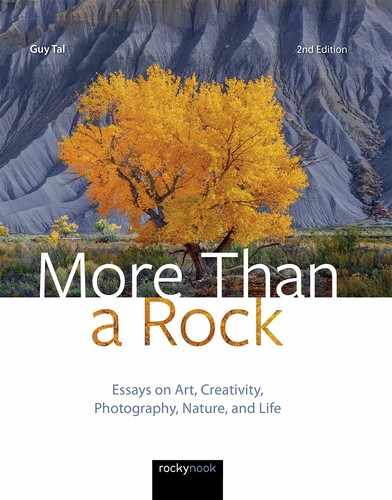On Significance59
The object becomes aesthetically significant when it becomes metaphysically significant.
—Joseph Campbell
For many years I used the term “meaningful” when referring to expressive images, by which I mean images that express something of an artist’s own mind rather than just illustrating the objective, literal characteristics of objects or scenes. Such references often sparked controversy from both representational photographers (generally asking why it is not enough for an image to just be beautiful or interesting) and from those schooled in the arts, who often subscribe to some variation of “art for art’s sake,” suggesting that art should have no inherent purpose or meaning, leaving such impressions to viewers to fill in.
After several such heated discussions, I realized that the term “meaningful” was problematic, as it colored the perceptions of viewers and students, leading them to the inevitable question, “so, what does it mean?” The question suggests that the image did not accomplish its desired effect, and that viewers become prejudiced and hung up on what the work’s meaning is supposed to be, rather than allowing the work to affect them intuitively.
Whatever meaning a work of art may possess or express cannot always be forced into words nor fit within the strict constructs of verbal language and grammar. To avoid such pitfalls, I decided to use the term “significant” instead of “meaningful.” Although English language thesauri list these words as synonymous, they in fact prompt different intuitive perceptions. Rather than “what does it mean?” I find that, when a work is presented as “significant,” most people are not moved to ask anything at all. Unlike meaning, which is usually perceived as something that can be expressed in words, significance is taken as a more personal quality to be perceived intuitively: something can feel significant even if we don’t know exactly what it means, or why. Such a response is also more complementary to the way sensory stimuli are processed by the human brain (as distinguished from the way we process verbal information), and how I believe art is best experienced.
Significance can originate from both the artist and the subject portrayed in the work. A magnificent and rare feat of natural beauty has significance in itself, even if the photographer’s role is limited to the simple mechanics of recording the view using a camera. But, the kind of significance I refer to here is one that is created rather than captured, originating primarily not from the subject, but from the mind of the photographer, and expressed using the subject. I believe that such subjective significance is a more worthy and difficult goal for an artist to strive for than any significance rooted in objective aesthetics, as it requires greater skill, knowledge, and insight than just applying the mechanics of photography, and offers viewers something they may never have experienced on their own. More important, it demands that the photographer live, know, and experience to have significant things worth expressing.
